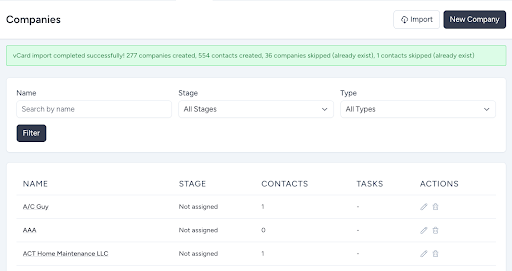
Exporting Apple Contacts
Exporting Apple Contacts
Apple Contacts is a popular app for contact management, but its popularity stems more from the fact that it is ubiquitously available on iOS and macOS than anything else. After all, it isn't a particularly capable address book, and hasn't been updated in years. Therefore you may have arrived at this post after attempting to export the Contacts data into another contact management solution and finding doing so isn't as easy as it would seem. I recently imported my own contacts into the personal and small business CRM 6DollarCRM, and in this post I’ll show you what I learned along the way.
Apple Contact Export Formats
If you open the Apple Contacts app and then click File > Export, you'll see options for exporting as a PDF, as a vCard, or as something called a Contacts Archive. Exporting as a PDF isn't particularly useful unless you're planning on going off grid, although admittedly occasionally exporting and printing a PDF backup might not be a bad idea just for peace of mind. But a PDF isn’t going to be of much use if you want to import the data into another contact manager, leaving the vCard and Contact Archive formats as the remaining options.
Apple Contacts vCard Format
vCard is a standardized format managed by the IETF (Internet Engineering Task Force), and formally defined in RFC 6350. You’ll find vCard format is widely recognized as an import option by mobile phones, CRMs, and almost ever mainstream solution involved in contact management. A simple vCard-formatted contact looks like this:
BEGIN:VCARD
VERSION:3.0
FN:John Doe
TEL;TYPE=CELL:+1-555-123-4567
EMAIL:[email protected]
END:VCARD
If you want to export just one contact from Apple Contacts, enter the Contacts app, select the desired contact, and then navigate to File > Export. After choosing the save location, you can optionally open the .vcf file in your terminal or a text editor just to see what it looks like. Here is an example card exported from my personal Contacts list:
BEGIN:VCARD
VERSION:3.0
PRODID:-//Apple Inc.//macOS 15.5//EN
N:;;;;
FN:Ace Hardware
ORG:Ace Hardware;
TEL;type=CELL;type=VOICE;type=pref:(614) 291-0820
X-ABShowAs:COMPANY
END:VCARD
You could then share this file over text message, and the receiver’s phone will recognize it as a contact that can be added to their own address book.
Of course, you’ll probably want to export multiple or more likely all of your contacts. To do so, make sure All Contacts is highlighted, then click into your first contact, then press cmd+a to select all contacts.

Then as before, go to File > Export and choose Export vCard. The resulting file will contain not one but all vCard entries associated with the contacts you selected. For instance here are the first two entries in my own export:
BEGIN:VCARD
VERSION:3.0
PRODID:-//Apple Inc.//macOS 15.5//EN
N:;;;;
FN:AAA
ORG:AAA;
TEL;type=CELL;type=VOICE;type=pref:(800) 222-4357
X-ABShowAs:COMPANY
END:VCARD
BEGIN:VCARD
VERSION:3.0
PRODID:-//Apple Inc.//macOS 15.5//EN
N:;;;;
FN:Ace Hardware
ORG:Ace Hardware;
TEL;type=CELL;type=VOICE;type=pref:(614) 291-0820
X-ABShowAs:COMPANY
END:VCARD
…
From here you’ll import your vCard file into the desired destination service. Later in the post I’ll show you how easy this is accomplished using 6DollarCRM but for now let’s move on to the next supported Contacts app export format: Contacts Archive.
Apple Contacts Contacts Archive Format
This is a proprietary Apple format called "Address Book Backup" which when selected will create a file having an .abbu extension. The abbu name is an abbreviation for Address Book Backup. What’s really interesting about this file is it isn’t a file at all. It’s actually a macOS package which presents as a file but can be entered just like a directory. If you create an archive and then enter it using your terminal, the contents will look something like this:
✘ wjgilmore ~/Downloads cd Contacts\ -\ 07-20-2025.abbu
wjgilmore ~/Downloads/Contacts - 07-20-2025.abbu ll
total 10248
-rw-r--r--@ 1 wjgilmore staff 48K Jul 8 19:04 ABAssistantChangelog.aclcddb
-rw-r--r--@ 1 wjgilmore staff 32K Jul 18 14:15 ABAssistantChangelog.aclcddb-shm
-rw-r--r--@ 1 wjgilmore staff 1.0M Jul 18 14:15 ABAssistantChangelog.aclcddb-wal
-rw-r--r--@ 1 wjgilmore staff 556K Jul 12 13:07 AddressBook-v22.abcddb
-rw-r--r--@ 1 wjgilmore staff 32K Jul 20 12:13 AddressBook-v22.abcddb-shm
-rw-r--r--@ 1 wjgilmore staff 3.3M Jul 20 12:08 AddressBook-v22.abcddb-wal
-rw-r--r--@ 1 wjgilmore staff 44K Oct 26 2018 MailRecents-v4.abcdmr
-rw-r--r--@ 1 wjgilmore staff 32K Oct 26 2018 MailRecents-v4.abcdmr-shm
-rw-r--r--@ 1 wjgilmore staff 4.1K Oct 26 2018 MailRecents-v4.abcdmr-wal
drwx------@ 6 wjgilmore staff 192B Jul 20 12:08 Metadata
drwxr-xr-x@ 10 wjgilmore staff 320B Mar 15 2024 Sources
Believe it or not these files are openable by the SQLite database! If you have SQLite installed, try opening the .aclcddb file:
$ sqlite3 ABAssistantChangelog.aclcddb
-- Loading resources from /Users/wjgilmore/.sqliterc
SQLite version 3.43.2 2023-10-10 13:08:14
Enter ".help" for usage hints.
sqlite> .tables
ZABASSISTANTCHANGELOG ZABASSISTANTSEQUENCE Z_MODELCACHE
ZABASSISTANTFULLSYNC Z_METADATA Z_PRIMARYKEY
sqlite> .quit
I’m not really sure how practical this knowledge is in the grand scheme of things, but it is kind of interesting to get a glimpse at how Apple manages things under the hood. Furthermore, Apple’s Contact Archive format is effectively ignored by other vendors and is therefore unlikely to be recognized by anything other than, well, Apple Contacts.
Importing Apple Contacts Into 6DollarCRM
After signing up for a 6DollarCRM trial you’ll be presented with the following welcome screen. You can manually add a contact, manually a company, or automate the process using one of several available import tools.

Click View Import Tools and you’ll next be presented with the following screen:

Click Import Apple Contacts and you’ll see this screen:

After exporting one, several, or all of your Apple Contacts to vCard format using the process described earlier in this post, upload the vCard file or drag the file into the widget represented by the dotted line, then press the Upload and Import button. After a few moments you’ll be redirected to the Companies dashboard, where you’ll see a status update similar to the following:

Conclusion
If you’re looking for an easy and much more powerful way to manage your personal and small business contacts, check out 6DollarCRM. As the name makes clear, it’s a CRM that costs just $6 a month.